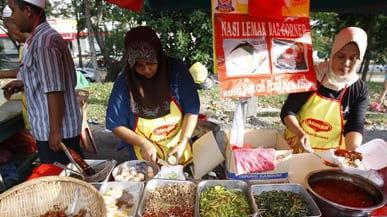Public diplomacy is a field predicated on the communication of culture and values to foreign publics; gastrodiplomacy is the act of winning hearts and minds via stomachs. Gastrodiplomacy uses culinary delights to appeal to the global public’s appetite, and thus helps raise a nation’s brand awareness and reputation.

Gastrodiplomacy as foreign policy was first cooked up by Thailand, which used its kitchens and restaurants as outposts of cultural diplomacy. With the growing popularity of Thai restaurants globally, in 2002, the government of Thailand implemented the “Global Thai program” as a means to increase the number of Thai restaurants. The Thai government’s rationale, The Economist noted, was that the boom in restaurants, “will not only introduce delicious spicy Thai food to thousands of new tummies and persuade more people to visit Thailand, but it could subtly help deepen relations with other countries.”
More recently, both South Korea (“ Kimchi Diplomacy”) and Taiwan (“ Dim Sum Diplomacy”) have been engaging in culinary diplomacy to help increase global recognition of their respective nation brands.
Meanwhile, Malaysia is conducting a dynamic gastrodiplomacy campaign that has combined elements of culinary and cultural diplomacy. The country is a natural locale to carry out gastrodiplomacy. It was the spice-trading hub of Malacca that brought itinerant traders and successive waves of hungry European colonists ranging from the Portuguese to the Dutch and the British to the Straits of Malacca. Later, the British helped turn the island of Penang into a spice-trading entrepôt.
Malaysia has long been a gathering point for varied cultures, and its present mix of Malay, Chinese, and Indian flavors, as well as influences from Thailand and Indonesia, create distinctive and delicious culinary fares.
Such delicious Peranakan treats include asam laksa—a delicately sour tamarind fish soup with thick white noodles, bean sprouts, and mint.
The country has been conducting various forms of gastrodiplomacy for a number of years. In 2006, it embarked on a campaign to brand Malaysia as a center for halal food within the Muslim world.
In 2010, Malaysia kicked off Malaysian Kitchen for the World —a robust gastrodiplomacy campaign meant to create awareness about Malaysia as it creates awareness for Malaysian cuisine and recipes. The campaign has been carried out by the Malaysia External Trade Development Corporation (MATRADE) to promote Malaysian cuisine globally, with heavy emphasis on the U.S. and U.K.
“We are a multiracial, multiethnic society, so we have the Malay, the Indian, and the Chinese cuisines,” said Undersecretary Dato’ Than of the Department of Information and Public Diplomacy in Malaysia’s Ministry of Foreign Affairs. “Besides promoting Malaysia and branding it, the Malaysian Kitchen for the World helps strengthen relations in the countries we are promoting Malaysian cuisine. It is both cultural diplomacy as well as gastrodiplomacy.”
One of the more distinct styles of Malaysian food highlighted in the campaign is Malaysia’s Peranakan cuisine. Peranakan food was born out of Chinese migration and assimilation to the Malay Peninsula; this distinct culinary treasure deftly combines Malay and Chinese flavors for a subtle but spicy cuisine. Such delicious Peranakan treats include asam laksa—a delicately sour tamarind fish soup with thick white noodles, bean sprouts and mint, or kari mee—a spicy Malay-Chinese riff on traditional Chinese noodle soup that incorporate fiery red curry and coconut milk.
As part of the campaign, Malaysian Kitchen for the World has brought top Malaysian chefs to cook up Malaysian culinary fares at various food fairs and food-tasting events, as well as bringing renowned global chefs to Malaysia to learn about its cuisine. Online, the Malaysian Kitchen websites promotes different Malaysian recipes and offers an extensive list of where Malaysian cuisine can be located around the world. The Malaysia Kitchen campaign even helps arrange financing for Malaysian restaurants and restaurateurs abroad to support the expansion of Malaysian cuisine.
The campaign has also shown a bit of attention to local trends as it set up a food truck in New York to take advantage of the growing food-truck craze that has been sweeping across America. Both the campaign and Malaysian Kitchen food truck have taken advantage of social media to promote the initiatives via Facebook and Twitter.
The brilliance of Malaysia’s campaign is that it has also combined aspects of cultural diplomacy with its culinary outreach. In this regard, Malaysia has set up night markets in famous landmarks of cosmopolitan cities such as a Malaysian night market in the middle of London’s Trafalgar Square. More recently, this public diplomacy campaign touched both coasts of the United States as it set up a night market on Santa Monica’s bustling 3rst Street Promenade and in the hip Meatpacking District in New York City. Such cultural and culinary diplomacy is most effective, as it plays on all the senses, not just taste.
Malaysia’s gastrodiplomacy campaign has been a delicious way to create better awareness of Malaysia through its cuisine. Many other countries looking to engage in such forms of digestive diplomacy would be wise to study Malaysia’s recipe.
Paul Rockower is a gastronomist and graduate of the master’s of public diplomacy program at the University of Southern California. He is the communications director of Public Diplomacy Corps, an organization dedicated to bringing public diplomacy to the public. He recently spent a month traveling in Malaysia. You can follow his blog here.






